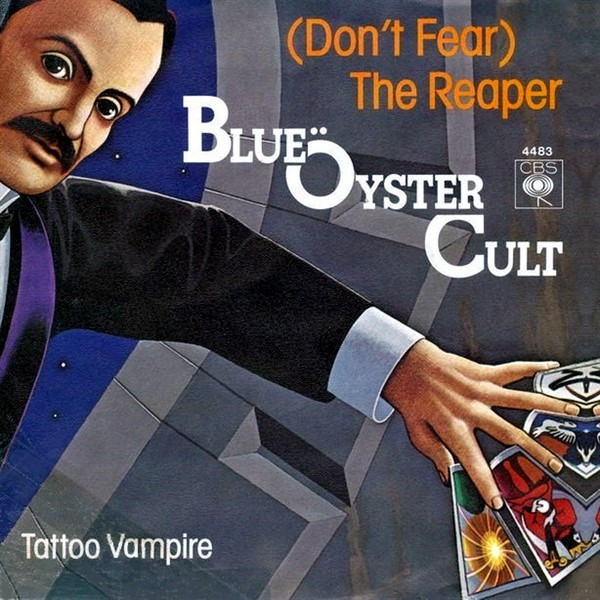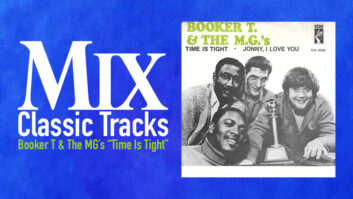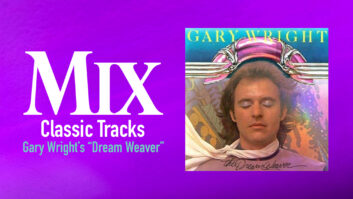It still ripples through our culture. Released more than 30 years ago, Blue Öyster Cult’s “(Don’t Fear) The Reaper” has become a touchstone. It is still heard on classic-rock stations, in movies (Halloween and others) and even in videogames (Rock Band). And who can forget Saturday Night Live‘s “more cowbell” skit, which parodied a behind-the-scenes look at the track’s production.
Appearing on BÖC’s Agents of Fortune album, “(Don’t Fear) The Reaper” peaked at Number 12 on the Billboard Pop Singles chart in October 1976 — surprising for a hard-rock band known for its literate lyrics. But like a velvet hammer, “Reaper” is paradoxically soft and powerful. It’s built around an immediately compelling guitar riff. The vocals speak of bravely facing one’s mortality.

Blue Öyster Cult got their start in 1967 in upstate N.Y. when guitarist/vocalist/songwriter Donald “Buck Dharma” Roeser and drummer/vocalist/songwriter Albert Bouchard started a band. They met up with Sandy Pearlman, who was a contributor to the rock magazine Crawdaddy, and he became the band’s manager, producer, lyricist and mentor. Pearlman created the band’s name and signature icon (a cross merged with an upside-down question mark). He also came up with stage names for the bandmembers; only Buck Dharma kept his nickname.
The band recorded their first demos in a New York City 8-track jingle studio owned by David Lucas. Pearlman brought those demos to his friend Murray Krugman, who was a product manager at Columbia Records. Krugman arranged an audition with Clive Davis, who signed them to a record deal in 1971. BÖC’s Columbia debut was based on the demos recorded at Lucas’ studio. The next two albums, which achieved Gold Record status, were recorded in Columbia/CBS Studios. During this time, the band became famous for their live shows — even sharing the stage with Black Sabbath on the notorious “Black and Blue” tour — but they had yet to score a hit single.
The band wanted more autonomy on the choice of recording studio for their fourth studio record, Agents of Fortune, and chose to work at Record Plant New York City. “Cheap Trick had been there, Aerosmith had been there, Blondie was there,” recalls Roeser, who still tours with BÖC. “We felt that we needed to access this pool of success and talent so that we could sell some records.”
Before heading into the Record Plant, each member of the band acquired newly affordable “pro-sumer” TEAC 4-track recorders to aid in their songwriting. Using his TEAC 3340S reel-to-reel and a couple of mics, Roeser recorded a demo of “(Don’t Fear) The Reaper” in his spare room.
Roeser was thinking of his own mortality when he wrote the song. “It’s a song about fate,” he explains. “The idea of the song came from a worry that I wasn’t going to live long. The riff came out of the ether; it just came to my fingers. Then the first two lines of the lyrics came the same way. I recorded some of the vocals, and then the idea of the song came to me. That was my first experience with multitrack recording. It definitely changed the way Blue Öyster Cult wrote and arranged songs. Once we started writing songs using the multitrack recorders, our demos got more fleshed-out and thought-through.”
Pearlman, who currently teaches at McGill University in Montreal, noticed the change in the band’s songwriting and arranging. “In 1976, a whole bunch of cheap, but fairly decent, multitrack recorders were available,” he says. “The members of the band began making more elaborate home demos. One of these demos was Buck Dharma’s ‘Reaper.’ I heard that demo, and I thought, ‘This is one of the greatest songs I’ve ever heard!’ I immediately recognized the guitar riff was not just box office but something extremely deep.”
“The signature guitar riff was recorded with a Gibson ES175 that belonged to Murray Krugman,” Roeser recalls. “He brought it in, and said, ‘Try this guitar.’ That’s what I happened to be playing when we recorded ‘The Reaper.’ It was recorded out of a MusicMan 410 combo amp. The lead solo was an overdub recorded with my 1969 Gibson SG running through the same amplifier.”
Shelly Yakus has recorded hit records for some of the biggest rock acts, including John Lennon, Tom Petty, Alice Cooper and U2. Currently designing sound for mystudio.net, Yakus was VP of Record Plant New York City when BÖC brought in the Agents of Fortune project. To capture the song’s signature guitar riff, Yakus recorded four tracks of guitar: a direct feed, one SM57 and one Beyer 160 close-miked on Roeser’s MusicMan 410 combo amp, and one Neumann U87 as a distant room mic. The guitar tracks were sent through an EMT plate and then recorded on an MCI 24-track. A 15 ips tape delay was recorded right on some of the guitar tracks during the recording.
Pearlman raves about the Record Plant’s gear of the era: “It was just great-sounding tape machines. Great-sounding console,” he says. “All these microphones dating from 1948 to 1976. And all this outboard gear. We used more outboard gear mixing Agents of Fortune than I had used at any time before that.” Some of the outboard gear used on “The Reaper” included Fairchild mono compressors, API 560 graphic equalizers, Flickinger EQs, and Roger Mayer and Pye limiters. (Roy Cicala was the driving force behind Record Plant New York City in those days and helped provide the top-notch gear.)
“(Don’t Fear) The Reaper” stands apart from other BÖC songs because Roeser sings a mellow lead vocal instead of the band’s primary vocalist, Eric Bloom, who is known for his edgy style. Roeser sang softly into a Telefunken U47 tube mic, which Yakus says, “lit up Buck’s voice. The room we recorded in was very dry with carpets and padding on the walls. But the room combined with the outboard equipment had a very cool sound.” The vocals went through a Pultec EQ and an LA-2A compressor right to tape.
As for the song’s drum sounds, Yakus explains, “A good snare sound adds excitement to the drum kit and the entire song.” To achieve that, he took the original snare track, gated it and then sent it back into the studio, where a snare was resting on top of an upward-facing speaker. A microphone was placed over the speaker/snare combination to capture snare hits. Yakus then blended the original snare with the “augmented” one.
Another distinctive percussion sound is the delayed hi-hat at the beginning of the guitar solo. “Record Plant has great-sounding echo chambers,” Yakus notes. “I sent the hi-hat into a tape delay and then into the chamber. I EQ’d the tape delay and EQ’d the reverb that came back from the chamber so that it matched the sound of the original hi-hat. Then I fooled with the tempo of the delay.”
During the final mix, Yakus worked from the top down: “I started with the voice, added the guitar that carries the song and then I put the rhythm section in after that,” he recalls. “I fooled with that balance until it felt really good. Then I added whatever instruments were left.”
“Shelly and I were in charge of the mixes,” Pearlman explains. “We would do submixes of the rhythm elements until they were solid. Then we would put the submixes through at least two pieces of gear from very different generations — like maybe a mono Fairchild and then an ADR — and we got some really interesting sounds.”
The production team worked on Record Plant’s unique DataMix console. “The console looked like an upright piano,” Yakus says. “The faders were in the usual place, but the equalizers and the meters were like an upright piano. You could hardly see over the top of it into the room. But that console sounded really, really good. They did Mountain’s ‘Mississippi Queen’ and John Lennon’s Walls and Bridges on that board.”
Yakus explains how he made Roeser’s guitar solo stand out in the mix: “We used a 4-track tape machine as a delay machine. We sent the guitar solo into the first track, and then the first track into the second, the second into the third, and the third track into the fourth. We then took an output from all four tracks up to the console, and we would mix all four delays with the original guitar track. We did this while sending the fourth track into the first track using a fader to control the level. At the time, people had daisy-chained channels before, but it was a little unusual to do it with a 4-track.”
“The guitar solo and the basic rhythm track were recorded in one take. They were not edited or punched into,” Pearlman adds. “We got fantastic analog ambiences from the live chambers and EMT plates. Because we had as many analog ambiences as we wanted, the song has this cloud of unknowing, this infinite extension.”
“We did a 5.1 remix of these tapes,” Yakus says of the song. “It was remarkable to hear what the mid-’70s equipment sounded like. The sounds by themselves were decent; it was a good recording. But when you heard it all together, when you put all the faders up, it was special. When that song starts out, in the first few notes, you know it’s ‘The Reaper,’ and it creates this vibe that just takes you over. There are a few songs that can do that, and ‘The Reaper’ is one of them.”
Probably the best-known cultural reference to the song is the “More Cowbell” skit on Saturday Night Live from a number of years back. In the skit, Christopher Walken portrays a producer known as Bruce Dickinson, and Will Farrell enthusiastically plays the cowbell as fictional character Gene Frankle. The routine is hilarious, but the original producer of the song was Pearlman; Dickinson was the re-issue producer. To this day, there is still some debate about who played the cowbell part: Both vocalist Bloom and drummer Bouchard claim to have played it. According to Roeser, “The idea of the cowbell was actually David Lucas’. And it’s not really that loud.”
Roeser’s skillfully arranged, recorded and mixed 4-track “Reaper” demo is now available on Columbia’s 2001 re-issue of Agents of Fortune. “My overriding concern was that the vibe of the demo be preserved,” Roeser says. “And I think that was successfully done. The final is very similar to the demo arrangement. In the moment of creation, I had no idea what the world would think of the song. It’s been gratifying to see something that has rippled out to the larger culture.”







